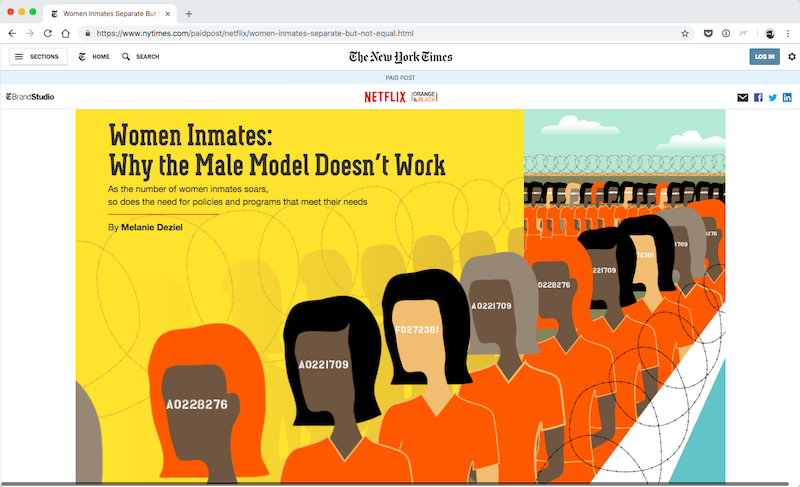Branded content is an alternative to traditional advertising and promotions. It can be any kind of content including videos, podcasts or articles. It’s a similar concept to content marketing with one significant difference. Branded content focuses on gaining awareness whereas content marketing is more tied to generating leads or sales. Branded content is meant to be entertaining or shining a light on a related issue instead of outright promoting a product or a company. On the other hand, content marketing is strictly about promotions.
The key is grabbing the attention of today’s consumer and driving real engagement through content. Branded content can entertain people or teach them something, resulting in better brand engagement returns than standard pre roll content.
The Mission, Branded Content: The What, Why, When, and How
Why does branded content work?
Traditional advertising isn’t as effective as it once was. Although content marketing works well, branded content can get a product in front of people without making them feel as if they are being directly advertised to. That’s the whole concept of branded content, after all! Never forget, that people don’t like being sold to which makes branded content so effective. More and more people skip or avoid advertising altogether; they even pay to avoid it. Therefore, consuming interesting or intriguing content creates greater retention and share rates because it’s not perceived as an outright sales tactic.
When you make your piece of content about something else other than your product such as some guy learning extreme sports in 5 days with the help a Fitbit, it’s going to be received, accepted and shared a lot more than content about how awesome Fitbit is for extreme sports. That’s the key to branded content.
A study from Syracuse University (by IPG Media Lab, Forbes and S.I. Newhouse School of Public Communications) found that in brand content the brand recall is 59% higher compared to traditional ads. Why is that? Part of it has to do with attention, interest, and engagement. We tune one during advertisements and we see them as biased. But, with branded content we’re invested in the story, therefore, we pay attention to details such as which products helped the person in the story achieve their goal. Because branded content gets more attention it, in turn, creates more brand recognition!
Brand recall is 59 percentage points higher for branded content, and consumers were 14 percent more likely to seek out more content from the brands after a single exposure to branded content. … Additionally, branded content was perceived more positively than display ads, with consumers more likely believing that the content is intended to educate.
New Study Reveals Branded Content Is Twice As Memorable As Display Ads
A perfect example of branded content: Dove’s Real Beauty Sketches
You may remember back in 2013, Dove’s Real Beauty Sketches campaign. The company noticed through their research that only 4% of women polled would describe themselves as “beautiful.” Not that’s a shockingly low number!
They used this to create the Dove’s Real Beauty Sketches video series. In these videos, a woman would describe herself to a sketch artist and then a stranger she met that day would describe her too for a second sketch. Afterward, the woman would see the two sketches which often resulted in two very different images of her. The self-described sketches would focus on her self-conscious areas whereas the second, stranger describe sketch, would be significantly more gentle and focused on the woman’s positive features. Not only is this so emotional but also thought-provoking for both the women in the video series but also anyone watching them.
Beauty is for everyone. Dove invites all women to realize their personal potential for beauty by engaging them with products that deliver superior care.
The Dove Real Beauty Pledge
Needless to say, the Dove’s Real Beauty Sketches series went viral; they received over 50 million views in just their first 12 days online. And over 114 million views in their first month.
That’s some powerful shit! Do you think their campaign would have been as powerful if it was a traditional ad telling women one by one that “yes you’re beautiful! Don’t forget to use Dove!”? I don’t think so either.
Rocking Men’s Health and Fitbits
Writer Clint Carter had to master an extreme sport such as highlining in just 5 days and put himself in an extreme situation on day five of said challenge. Men’s Health published articles and videos documenting Clint Carter’s five days adventures titled “The Adventurist”. And yes, watching or reading about Clint Carter is hella entertaining without feeling you’re being advertised to while Fitbit was being mentioned in the background as a tool he used during his 5-day challenge. Clint has tried many different things such as mastering 7 BMX tricks, 60-foot high line and freestyle ski jump. In June 2018, he even tried to become an American Ninja Warrior in a single month.
While reading about Clint’s challenge, you get to know all sorts of things about him and his adventures. The articles and videos including who was helping him, how he was dealing with learning these new skills and all sorts of details about the extreme itself too. He does mention Fitbit here and there. He used it mostly to glance at his heart rate as he’s practicing the sports. The promotion is in there but it’s not the point at all, Clint and his adventure are!

In the video you can see Client practicing and falling off the high line while he’s up trying to walk the highlight on a mountain cliff; this branded content grabs you by the balls. I’m serious, it’s super entertaining and interesting – have a look!
(FWIW: The idea actually originated with Men’s Health and they reached out to Fitbit, not the other way around it!)
Spreading awareness with branded content
Another example which I really love is Netflix publishing an article in The New York Times about female inmates. Instead of writing about the show itself, they wrote a thorough article on the true and real issues female inmates face day-to-day. Of course, this was related to their new show, Orange is the New Black! No doubt about it! But once again, this piece is branded content which puts the focus on real inmates instead of on the show itself. More specifically, the article called out male-focused protocols and procedures which don’t suit female inmates especially so since the number of them has increased by eightfold in the last three decades alone.

The piece is called “Women Inmates: Why the Male Model Doesn’t Work” and I highly suggest reading it! In it, the author, Melanie Deziel sheds lights on serious issues such as loss of identity and de-humanization, incarceration of the family in addition to the woman herself and difficulty finding work after release due to male-dominated work orders while in prison.
Approximately 1-million readers of The New York Times saw this article when it was first published. And however many since. Mind you, Orange is the New Black is not mentioned in the article itself. There is a little ad for it at the bottom of the page (which is actually outdated because it says season two is playing while the show is on its fifth) and with the paid post byline atop as well. That’s it. Yet I’m sure this piece branded content had a significant effect on the show’s viewership.
What can a small business owner do?
In short, the same exact thing as the big brands just with your own budget and reach. Though, I will never discourage you to dream big, if you think you can land an insightful article in The New York Time, fucking go for it!
Don’t forget, the idea behind branded content is to provide insightful and entertaining content that isn’t focused on your company or your product. All you have to do is find someone who is willing to publish it or partner with you on it. When you’re not pitching publishers a direct promotion, getting a yes is going to be significantly easier. Think of it as pitching a typical guest post or interview the difference is that the post or interview won’t be about you or your business but a related topic or cause.
Think about what kind of advice you can give, what cause can your business shed the light on or what kind of campaign can you put together? Do some research on complementing companies and pitch your idea. Working with others is a fantastic way to get your branded content noticed by their audience!
Here’s an example:
As a web designer, I love being featured on podcasts of business coaches where I give advice for business growth based on what I see my own clients or friends struggling with but from a web designer POV.
If I were to replicate the above three example here’s what I could do:
Replicating Dove’s Real Beauty Sketches
I could do a mini-video series with a business coach who is on prominent YouTube. In the mini0series, I could help a hand full of women overcome their branding self-doubts or fear of selling online. I am outspoken about the importance of mindset as a business owner. For example, I can walk these women through how their limited beliefs or self-sabotaging mindsets affect their online business growth. I could explain to them how self-doubt in raising their rates gives them self-doubt in the copy of their ads lowering their conversion rates. And so on…
Yes, I’d use my expertise as a designer but I’d be focusing on these women instead of pitching my services as a web designer.
things especially if I’ve dealt with these issues myself too.
Recreating The Adventurist
I could document how I work as a web designer through a single client project from the client contacting me to them going live with their new branding and website. I’d put the focus on the behind-the-scenes of what it’s like to be a self-employed web designer. While I’m documenting a project I can then occasionally mention an app I’ve partnered with. I would explain how I use it to make working with the client easier and smoother. It could be a design tool, an analytics tool or a time management app – whatever really.
The hypothetical documentary would be published independently, or maybe on the app’s own platform. It would focus on a day of a life of a web designer. Don’t forget, the spotlight here is on the behind-the-scenes; I’m neither selling my services not any app even though both these are of course clearly mentioned.
Recreating Women Inmates post
To recreate the Orange is the New Black example, what I could do is work with a publication such as Huffington Post, Inc. or Forbes. I could write an advice piece or an awareness piece. If we’re talking about advice, it could be, again, related to mindset. It can really be anything as long as I’m not directly promoting myself. To spitball some topic ideas:
- How self-doubt hurts your brand
- Solving self-sabotaging money mindsets to skyrocket your online sales
- The true extent of branding, from core values to loyal fans
Honestly, I could even turn this article you’re reading now into branded content!
If we’re talking about awareness, I could write a few pieces like these:
- On dealing with depression while self-employed
- Hurdles and inequalities of being a businesswoman in tech
- Having it all as a powerful, independent woman
Do you get the idea with branded content now?
The takeaway
If you’re looking to improve traffic, sales and awareness of your own business look into branded content. It’s not complicated; just a different style content. But, it has the power to significantly improve your brand’s visibility and reach.
Give yourself a small challenge to reach out to other business owners to partner with or online publication to publish you. Research 5 different branded content ideas relating back to your business. Pick the best one, or two, that you’d be most excited in working on over the next few weeks. Next, just pitch it to 5 publications or partnerships. Are you up for the challenge?!



